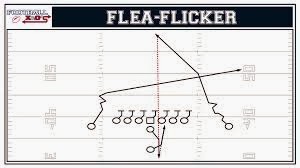As a football fan, I think I speak for all when I say that there is a soft spot in my heart for a good trick play. A trick play, depending on when it's called, can be a serious game-changer. The entire concept is to trick (hence the name) the opposing team into thinking you're doing one thing when you're really doing another. This is the first of multiple posts about trick plays, with each post focusing on one trick play and its variations. It's possible that this could be moved to another day and become a separate segment of its own, but we'll see.
pt. 1: the Flea Flicker
The flea flicker, along with being Joe Theismann's least favorite play, is popular all around college football. It can be described as this:
"1.an offensive play in which a pass is thrown to a receiver who then laterals the ball to a teammate.
2. An offensive play in which the ball is handed off or lateraled, often more than once, behind the line of scrimmage, and then thrown as a long pass down field."
Though technically by this definition:
"a trick play in football in which a forward pass is followed or preceded by a lateral or hand-off."
(Random House Kernerman Webster's College Dictionary, 2010)
a flea flicker can also be considered as a hook and ladder (as former Bulldogs explain here http://www.youtube.com/watch?v=dbHbq9cZN2w), but we'll save that form for another day.
Let's take a look at the most basic form of flea flicker:
This flea flicker ran by the Orange got them an early touchdown a couple of years ago in the Pinstripe Bowl
this diagram above ^ shows that this specific play only has two receivers, and the success of the play relies on both fooling the defense and having both receivers win in one-on-one coverage.
Flea flickers can also work with a pitch:
a double pass:
but my favorite kind is known as the "reverse flea flicker"
This play is usually ran in the wildcat, and it's meant to show the defense reverse and also get the ball into the guy who can throw downfield.
Take a notice that on all of these plays, like I mentioned on the first one, that there are for the most part one or two main routes that the quarterback is looking for. The majority of the routes in these clips include a receiver or tight end shuffling his feet and faking a block before releasing on his route. It's also noteworthy on how the lineman block on a flea flicker. They can't get too far ahead of the line of scrimmage, or else they will receive an ineligible man downfield penalty. Still, they also can't show pass block the entire time, or else they might reveal the true intentions of the play. These are the nuances of a successful trick play, and it takes a lot of practice and attention to detail for the play to work.
Take a notice that on all of these plays, like I mentioned on the first one, that there are for the most part one or two main routes that the quarterback is looking for. The majority of the routes in these clips include a receiver or tight end shuffling his feet and faking a block before releasing on his route. It's also noteworthy on how the lineman block on a flea flicker. They can't get too far ahead of the line of scrimmage, or else they will receive an ineligible man downfield penalty. Still, they also can't show pass block the entire time, or else they might reveal the true intentions of the play. These are the nuances of a successful trick play, and it takes a lot of practice and attention to detail for the play to work.
This article isn't really an analysis, but I'm trying to show how different teams use the same concept and make it their own. Also, it's pretty entertaining to watch how they look when they're properly exocuted. Also, an important thing to remember is that trick plays only work if everything works like it should. There's plenty of footage out there of trick plays that didn't work, either because they weren't set up properly, they weren't run correctly, or they just didn't make much sense (see http://www.youtube.com/watch?v=6-tqLG__Al4). These clips are the result of properly executed plays called at the right time. Not every gadget play works. It takes work, timing, and attention to detail to have success in any concept, let alone a gadget play. I hope you enjoyed this short report, and we'll get down to actual analysis next week.
Make sure to watch plenty of games this weekend, and as always, keep lovin' football.


No comments:
Post a Comment